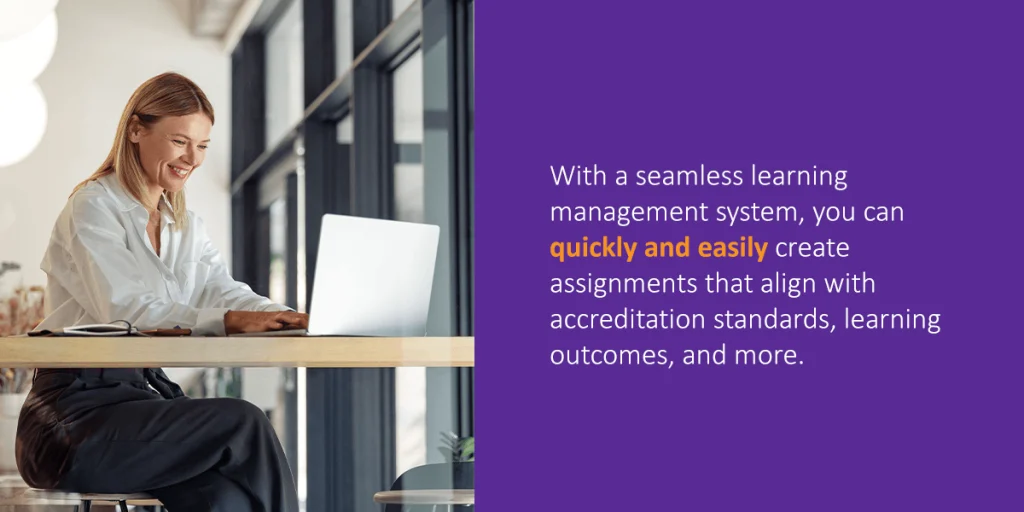




With learning taking place in the classroom, in the learning management system (LMS), in field and clinical placements, and elsewhere, it can be challenging to get the complete picture of what students have accomplished.
Created exclusively for higher education, Watermark Student Learning & Licensure offers a central hub for course-embedded and field experience assessment on campus. You can quickly and easily create assignments that align with accreditation standards, learning outcomes, and more, then capture evidence of learning directly from the source — students and faculty within the classroom.
With turnkey LMS integrations that automate assignment distribution, students are able to provide evidence right where they’re already working, and you’re able to glean deeper insights than you would from the LMS alone.
Watermark can provide you with the tools you need to improve, advance, and empower student success. When it comes time for collaboration across campus, we can help you gather, share, and glean insights from your student data much more simply. Consider the following ways Student Learning & Licensure can help with course-based assessment and placement at your higher education institution.
Student Learning & Licensure makes it simple to align standards to all of your assignments, including regional and programmatic accreditation standards, along with institutional learning outcomes. Within a lesson plan, you get a student-by-student breakdown of progress and can drill into the assignment to see what’s involved. Students can submit assignments directly within the LMS, and results are accessible within Student Learning & Licensure.
Providing a central view of a student’s program journey, Student Learning & Licensure helps you map and track progress across the “gateways”, or transition points and requirements, involved in each degree program. Gateways shifts the focus onto individual students, providing them with a clear understanding of program expectations and their status to ensure the progress they make translates to success. Details and status completion of curricular requirements, field experience, and other prerequisites are centralized in one accessible portal.
Faculty and administrators can monitor the status of requirements by program and cohort, or dive deep to support students individually where needed. Gateways provides a holistic view of student progress, making it easier for programs to support faculty and student success, assess student performance and program effectiveness, and illuminate opportunities for improvement.
Many instructors feel like their assessment results are sent off to a mysterious file, and they never get the results or feedback they need to improve. Student Learning & Licensure offers a source for instantaneous feedback, where faculty can see each element within a rubric and drill down into how students are performing. This makes it possible to identify trends and make real-time adjustments in the classroom.
Administrators can take a longitudinal view of this data and drill down into rubric results and performance across courses, programs, accreditation standards, and demographic factors. Comparative reporting makes it easy to understand trends over time and the relationships between actions taken to drive improvement and the results achieved. Role-based access limits who can access each report and ensures that users at all levels can only see the details they need to see.
With Student Learning & Licensure, it’s easy to tie partner sites, mentors, and students together to make field placements that best support each student’s program path. It begins with centralizing all the information you need about each partner site and field experience mentor, including contact information, site attributes, key notes on partners supporting students in the field, and each mentor’s expertise. Through upfront imports and intuitive tools for adding site details, plus a connection to the NCES database, it’s easy to build your partner site list.
From there it’s all about the students. The system will automatically surface which students are eligible for placement in the upcoming term together with their demographics and placement histories, giving coordinators a home base for assigning and tracking their next placements. Simply click in, filter for the specific site and mentor, make the assignment, and the placement is made! This triggers notifications of the match to the student, site, and mentor, and once the field experience begins, the student and mentor will receive the access they need to log time and assess the learning done in the field.
Student Learning & Licensure also aids coordinators with field placement management more broadly. Drawing from the information on individual placements, students, sites, and mentors, reporting on placements in aggregate and by attribute is straightforward and fast. So, whether the report is for internal review or compliance with an accreditor or licensure board, you can always get an accurate and full picture of placement for your program.
Students can create and curate dynamic portfolios to track accomplishments, goals, and future plans for professional development and growth. These can be shared outside of the university for employment searches, graduate school applications, and even summative assessments.
Student Learning & Licensure’s timeline feature puts a student’s complete body of work in chronological order and is searchable by keyword. Results are automatically pulled in from the LMS, and any missing assignments can be manually added as needed. Students have complete flexibility, making it easy for them to create unique ePortfolios that include details relevant to their goals. It’s simple for students to share on social media or send the URL to potential employers or schools.
Student Learning & Licensure allows students to easily pull artifacts from the LMS to add to their portfolios, with grades flowing to and from the system while eliminating duplicate entries. The system integration also deduplicates and streamlines the distribution of signature assignments so you can present them to students in a familiar environment — their LMS – and assess their work through a rubric.
All of this data being captured allows for quick and easily generated reporting. Depending on the user and their access and need, Student Learning & Licensure can deliver reports at different levels. For instance, faculty have access to immediate assignment-level reporting to track student progress while admins have the ability to run reports on rubrics and standards and view data at various levels, including longitudinally, comparatively, and demographically.

Through comprehensive data collection, ePortfolios allow you to collect a wide range of evidence and artifacts related to your student learning outcomes, institutional goals, and program effectiveness — simplifying the process of gathering evidence required for accreditation. With a seamless learning management system, you can quickly and easily create assignments that align with accreditation standards, learning outcomes, and more.
For instance, Student Learning & Licensure allows you to create different thresholds that align with your standards, and rubrics are flexible in how you create and deploy them. Educators can create their own rubrics tailored to specific accreditation criteria and standards, and you can capture evidence of learning directly from students and faculty in their classrooms.
Instead of maintaining paper-based documentation, Student Learning & Licensure allows you to digitize and centralize evidence, streamlining the documentation process and making it easier to access and organize the necessary materials and enhance accreditation reports.
We offer a set of tools in partnership with the Educator Disposition Assessment (EDA) to help you evaluate candidate dispositions across different programs, from traditional educator preparation programs to educational leadership and online programs.
Each of our Watermark-EDA packages includes:
Additionally, through our partnership with the Stanford Center for Assessment, Learning, and Equity, our tools can help ensure that underserved students have access to deeper learning and are well-prepared for success in college and beyond.
Take a deep dive and learn all that Student Learning & Licensure has to offer. Watermark’s Educational Impact Suite (EIS) also provides a robust suite of solutions to help you gather insights, inspire progress, and collaborate across campus. Ready to see more? Request a demo to explore our solutions, today!






























































































































































































































































































































































































